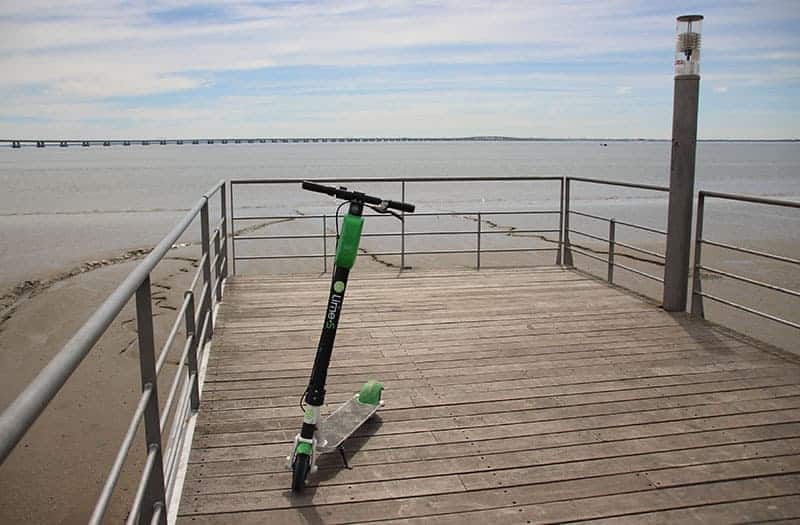How environmentally friendly and sustainable are e-scooters? In Berlin, as in many other major cities in Germany, they have been creeping along the streets every day for several years now - causing both head-shaking and enthusiasm. They are advertised primarily with the aspect of sustainability. But are e-scooters really that sustainable?
In this article, I would like to tell you more about the definition and the main advantages and disadvantages of e-scooters and check how environmentally friendly they actually are. Let's go!
Here you can find a short overview in advance:
Definition: What are e-scooters anyway?
E-scooters (also known as electric scooters) are in principle ordinary scooter, with the subtle difference that they are Electric motor and not driven by foot kick.
In Germany's major cities, they have been used for many years in the sense of Share Economy can be borrowed. Payment is based on the period of use. With the respective provider's app, the e-scooter can be easily located, unlocked and - powered by electric energy - conveniently used "on-demand" (i.e. when needed).
The e-scooters are primarily intended to Reduce CO2 emissionsminimize particulate pollution in city centers, relieve traffic congestion, reduce the shortage of parking spaces and, of course, save a lot of time.
Advantages and disadvantages: What are the pros and cons of an e-scooter?
With the advantages and disadvantages of the new-fangled e-scooters, we are now simply slowly getting to grips with the Answer to the initial question sustainability. They make it clear why opinions always fluctuate between curse and blessing.
Advantages of e-scooters
There is always at least one good reason for a new product/vehicle to be launched on the market. So what are the advantages of using a rented e-scooter?
- Speed: The maximum speed of the scooters is for adults and minors at 20 km/h - and is significantly faster than walking.
- Flexibility: They are located in many places in the city, you can use them to get from A to B quickly and also take the scooter home to recharge.
- Electromobility: The simple use of an e-scooter with the provider's app brings people into contact with climate-friendly, sustainable e-mobility. This increases acceptance in our society.
- Compact: On average, an e-scooter weighs around 10 kilograms (generally between 7 and 20 kilograms) and is therefore relatively easy to carry. As it is very narrow, you can also get through narrow streets in the city.
- Time saving: Compared to the car, which can get stuck in traffic jams, and public transport, which sometimes takes "long detours", the e-scooter can take you directly to your destination.
- Night drive: If there are no more streetcars at night, you can get home relatively quickly, easily and safely with an e-scooter.
Disadvantages of the e-scooters
Of course, we also have to look at the other side. The following disadvantages illustrate why e-scooters are often criticized:
- Environmental Harmfulness: The short service life, coal and nuclear power as well as lithium batteries from dangerous and nature-destroying opencast mining are just a few examples.
- Purpose of e-scooters: They are supposed to replace car journeys. But in practice, they often replace journeys that could actually be made on foot, by bike or by train. A lack of exercise can also exacerbate health problems.
- Risk of accident: According to the DGU (German Society for Orthopaedics and Trauma Surgery), e-scooters pose a considerable risk of accidents. The Footboards are deepso that the foot quickly gets caught underneath.
- Price: The TIER e-scooter costs 0.15 cents per minute of use, which is around 9 euros per hour. Depending on how long you want to ride it, the rental can therefore be relatively expensive.₃
- Harassment: The resentment in society towards the scooters is exacerbated by the fact that the scooters are in the way or their users ride them around uncontrollably - and without observing the traffic rules.
- Handling: Not everyone treats borrowed electric treadmills with care. The devices are often sunk into rivers or put down after use, blocking entrances and sidewalks.
- Weather dependency: The scooters are not used in all weathers. It can be seen that the use of e-scooters decreases significantly both in the rain and generally in the cold season.
- Traffic Obstacle: The scooters are approved for road use. As they only travel at a maximum speed of 20 km/h, whereas bicycles can reach significantly higher speeds, e-scooters are sometimes an obstacle to traffic on the road.
Sustainability: Why e-scooters are (only partially) environmentally friendly

Of course, an e-scooter offers a great deal of flexibility and, above all city life more sustainable do! However, providers tend to greenwash their modern technical road users with the sustainability aspect, as they can only influence actual use to a limited extent. The e-scooters are by no means sustainable in principle.
Here are some Factors that have a negative impact on the sustainability of e-scooters:
- The share renewable energies of the electricity mix in Germany is 61.5 percent. Nevertheless, depending on the user, the electricity for e-scooters often still comes from conventional, environmentally harmful energy sources.
- Many devices are vandalized. Vandalism has even become a viral trend.1
- On average, a scooter should last around 3 months - then it is e-waste. In Louisville (USA), a survey revealed that e-scooters even last only 29 days old and therefore do not even survive a whole month.
- Raw materials such as cobalt and lithium have to be mined for the batteries.2 In addition, production in China generally only works with high energy consumption - with energy from coal-fired power plants.3
- A study in France found that scooter journeys only replaced 8 percent of car journeys.4
Whether an e-scooter is sustainable depends more on how it is used
If they replace car journeys exclusively or for the most part, well maintained and on the road with renewable energy would be sustainable e-scooters in my opinion.
The study of the Fraunhofer Institute ISIcarried out on behalf of the provider "Lime"confirmed this assumption. The effects of shared e-scooters and e-bikes on CO2 emissions in six cities were investigated.
The results show that Micromobility services can certainly reduce greenhouse gas emissions from transportation if they replace emission-intensive means of transportation such as cabs or combustion-powered cars. However, they increase emissions if they replace active modes of transportation such as walking or private e-bikes.
So are e-scooters sustainable? It depends!
If you use an e-scooter to replace train and bicycle journeys or walking, this is of course not in the interests of sustainability - moreover, e-scooters do not change the fact that cycle paths need to be expanded and public transport needs to become significantly cheaper.
But with the right approach, the Switch to green electricity* and the e-scooter as an alternative to the car, you can travel sustainably.
So if you're interested in getting your own e-scooter, then I can recommend this one* recommend, because it Foldable and has a High range, a Shopping basket and a Second seat has. This means you can use it for as many activities as possible that you would otherwise probably prefer to do by car 🙂
"Everyone wants to get back to nature. But no one on foot."
Werner Mitsch (more at Mobility Quotes)
Do you have any questions, suggestions or your own experiences on the topic of e-scooters and sustainability that you would like to share? Then feel free to leave a comment below this post.
Stay sustainable,

PS: Take a look at the Sustainability Blog of CareElite. There you will get many more Tips for sustainable living. Appropriate to the article I recommend you for example the contributions about the car free life and the sustainable driving.
References:
- STANDARD Verlagsgesellschaft: Hatred of e-scooters: Instagram account celebrates destruction of the devices (as at: 12.07.2019), available at https://www.derstandard.de/story/2000104683990/hass-auf-e-scooter-instagram-account-zelebriert-zerstoerung-der-geraete. [01.10.2024]. ↩︎
- Federal Environment Agency: How environmentally friendly are e-scooter batteries? (as of 02.09.2019), available at https://www.umweltbundesamt.de/service/uba-fragen/wie-umweltfreundlich-sind-die-akkus-der-e-scooter. [01.10.2024]. ↩︎
- Axel Springer Deutschland GmbH: Environmentally friendly electric scooters? It's not that clear-cut (as of 15.05.2019), available at https://www.welt.de/wissenschaft/article193547157/Umweltfreundliche-Elektroroller-So-eindeutig-ist-das-nicht.html. [01.10.2024]. ↩︎
- 6t-Bureau de Recherche; PULS Reportage (2019): Juicer self-experiment: Charging an e-scooter - is it worth it?, YouTube, 21.08.2019, Web, 01.10.2024 at 12:42, in: https://www.youtube.com/watch?time_continue=465&v=hlZqt9lBs8I. ↩︎








